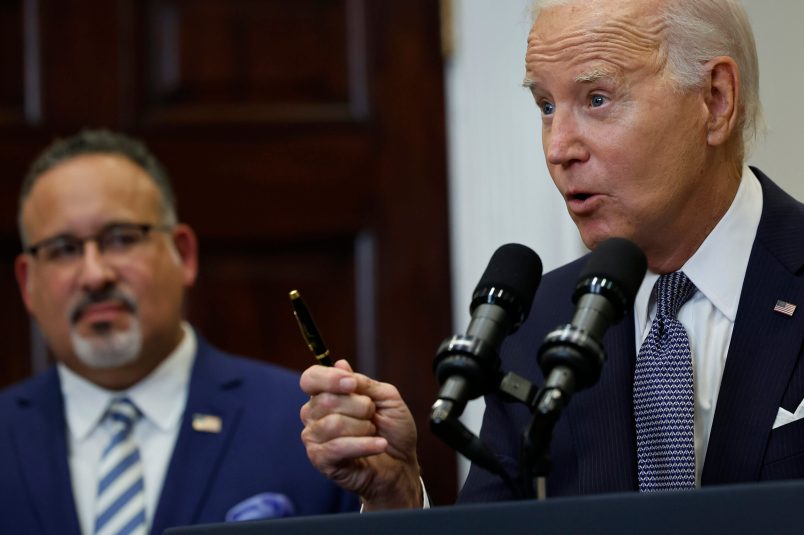In the hours after the Supreme Court knocked down his student debt relief plan on Friday, President Joe Biden announced in an Oval Office speech that he’ll take a different pathway to forgive the loans.
“We will ground this new approach in a different law than my original plan: the so-called Higher Education Act,” Biden said. “That will allow Secretary Cardona, who is with me today, to compromise, waive or release loans under certain circumstances.”
“This new path is legally sound,” he added. “It’s gonna take longer — but in my view, it’s the best path that remains to provide as many borrowers as possible with debt relief.”
The White House released limited details of the plan on Friday. But the Department of Education had already initiated the rulemaking process for the new student loan forgiveness program, which will start with a virtual public hearing on July 18.
That plan, Biden said, will be coupled with another: a one-year “on-ramp repayment program.”
According to the White House, the new repayment program will run from October 1, 2023 to September 30, 2024 so “financially vulnerable borrowers who miss monthly payments during this period are not considered delinquent, reported to credit bureaus, placed in default, or referred to debt collection agencies.”
The administration also finalized what it’s touting as the “most affordable repayment plan ever created” to cut the amount borrowers have to pay each month, forgive debts after 10 years of payments instead of 20 for certain borrowers and not charge borrowers unpaid monthly interest.
The new path to relief seems to hinge on the Higher Education’s Act “compromise and settlement” authority, which some scholars have interpreted to give the Education Secretary broad latitude to waive debts. The longer process Biden alludes to is likely the rule-making and congressional review process for the agency action.
If the new pathway is finalized, it will almost certainly also be challenged in court. The Supreme Court rejected Biden’s old student debt plan Friday in large part due to the major questions doctrine, a right-wing theory that lets the Court stop deferring to agencies when their actions are of “economic or political significance” — a vague threshold the right-wing majority has frequently used to knock down Biden administration agency actions.
Biden juxtaposed his attempts to get relief Friday — heavily opposed by Republicans — with many of those congressional Republicans’ netting of Paycheck Protection Program (PPP) loans during the pandemic.
“I’m never gonna stop fighting for you,” he said to the camera. “We’ll use every tool at our disposal to get you the student debt relief you need.”







Allowing us to hate the SC again next June when they strike that one down too.
One nice thing about Ken Paxton being sidelined, he’s not running to the courthouse to block President Biden’s initiatives.
I’m the parent of a child who will have substantial debt after graduate school. What strikes me is the interest rate, which accrues as soon as the loan amount is used. It would be helpful to get the interest rate down on the entire loan, so borrowers can pay more towards principal as they make their payments. That might be politically easier to swallow as well.
Biden is keeping hope alive. That’s very important.
If government could free up all this stagnate, bloated, dead-dog of student debt, we’d have a boom of wealth the likes of which nobody really has ever seen. That’s not Donald Trump. There’s so much money tied up in mere useless expense and such a pent-up need for all kinds of stuff to set a life and build a retirement… Elon could not count all the money he’d make.
A young person not only pays back the exorbitant cost of the education – labs, books, boarding, credit hours, whatever. They will have paid back enough in interest to buy another degree. Of course, they only get one degree for all that money.
The other part subsidizes a handout to a best friend on the Court.